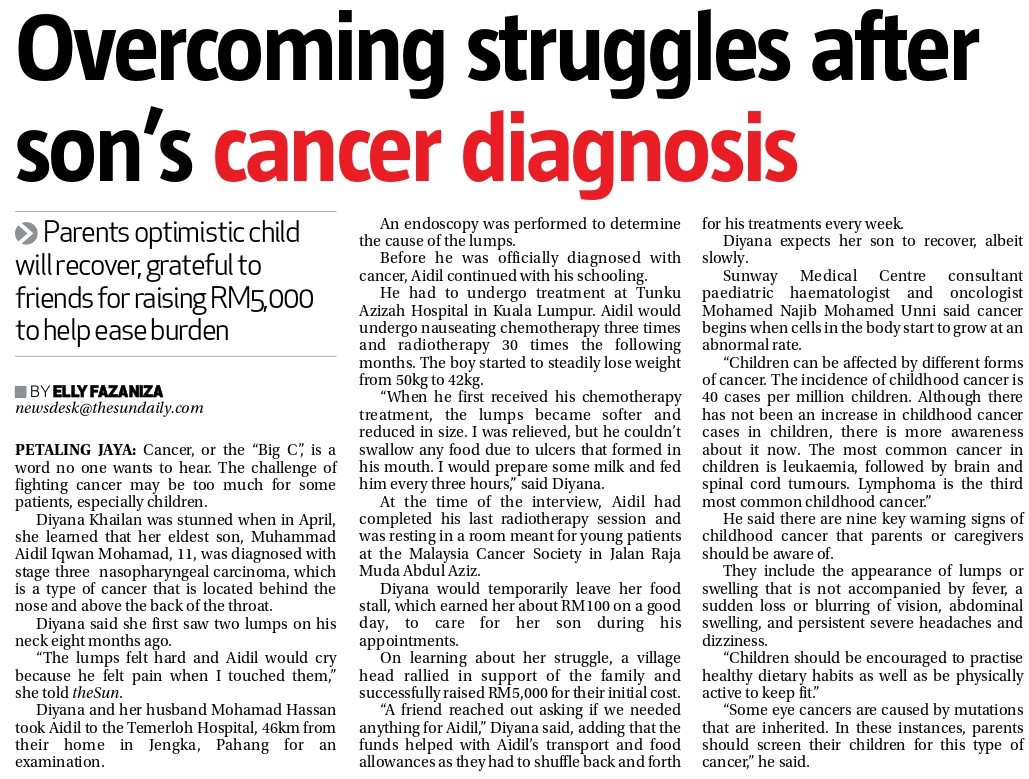Overcoming Childhood Cancer
12 October 2022

Cancer, or the “Big C”, is a word no one wants to hear. The challenge of fighting cancer may be too much for some patients, especially children.
Diyana Khailan was stunned when in April, she learned that her eldest son, Muhammad Aidil Iqwan Mohamad, 11, was diagnosed with stage three nasopharyngeal carcinoma, which is a type of cancer that is located behind the nose and above the back of the throat.
Diyana said she first saw two lumps on his neck eight months ago.
“The lumps felt hard and Aidil would cry because he felt pain when I touched them,” she told theSun.
Diyana and her husband Mohamad Hassan took Aidil to the Temerloh Hospital, 46km from their home in Jengka, Pahang for an examination.
An endoscopy was performed to determine the cause of the lumps.
Before he was officially diagnosed with cancer, Aidil continued with his schooling.
He had to undergo treatment at Tunku Azizah Hospital in Kuala Lumpur. Aidil would undergo nauseating chemotherapy three times and radiotherapy 30 times the following months. The boy started to steadily lose weight from 50kg to 42kg.
“When he first received his chemotherapy treatment, the lumps became softer and reduced in size. I was relieved, but he couldn’t swallow any food due to ulcers that formed in his mouth. I would prepare some milk and fed him every three hours,” said Diyana.
At the time of the interview, Aidil had completed his last radiotherapy session and was resting in a room meant for young patients at the Malaysia Cancer Society in Jalan Raja Muda Abdul Aziz.
Diyana would temporarily leave her food stall, which earned her about RM100 on a good day, to care for her son during his appointments.
On learning about her struggle, a village head rallied in support of the family and successfully raised RM5,000 for their initial cost.
“A friend reached out asking if we needed anything for Aidil,” Diyana said, adding that the funds helped with Aidil’s transport and food allowances as they had to shuffle back and forth for his treatments every week.
Diyana expects her son to recover, albeit slowly.
Sunway Medical Centre Consultant Paediatric Haematologist and Oncologist Dr Mohamed Najib Mohamed Unni said cancer begins when cells in the body start to grow at an abnormal rate.
“Children can be affected by different forms of cancer. The incidence of childhood cancer is 40 cases per million children. Although there has not been an increase in childhood cancer cases in children, there is more awareness about it now. The most common cancer in children is leukaemia, followed by brain and spinal cord tumours. Lymphoma is the third most common childhood cancer.”
He said there are nine key warning signs of childhood cancer that parents or caregivers should be aware of.
They include the appearance of lumps or swelling that is not accompanied by fever, a sudden loss or blurring of vision, abdominal swelling, and persistent severe headaches and dizziness.
“Children should be encouraged to practise healthy dietary habits as well as be physically active to keep fit.”
“Some eye cancers are caused by mutations that are inherited. In these instances, parents should screen their children for this type of cancer,” he said.
Source: The Sun
Back


